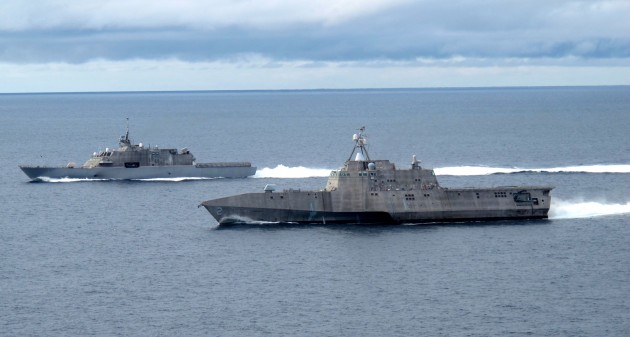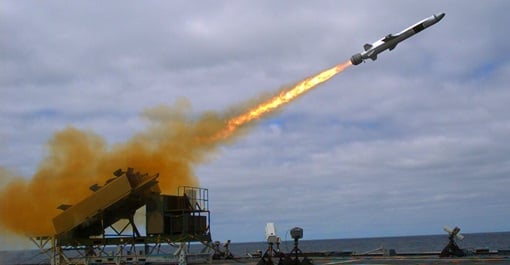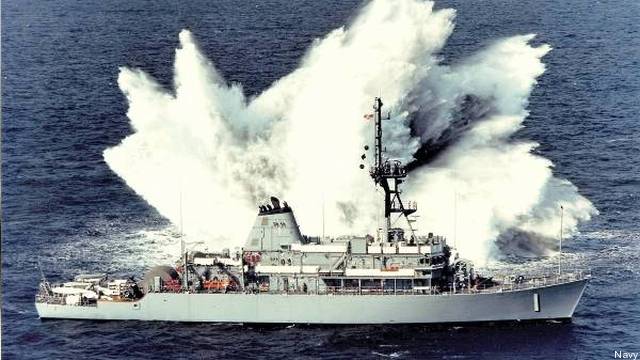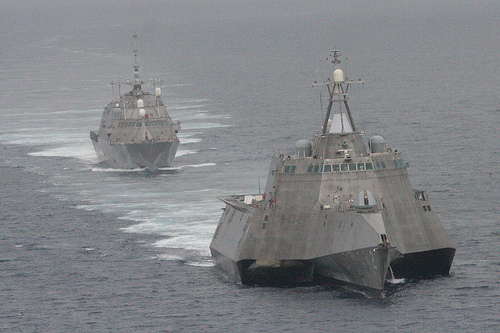LCS Grows Teeth, At Last…
Posted on

The two Littoral Combat Ship variants, LCS-1 Freedom (far) and LCS-2 Independence.
SURFACE NAVY ASSOCIATION: The Littoral Combat Ship is finally about to get the capabilities envisioned for it at the start, 15 years ago, Navy leaders told the annual conference here.
The four much-criticized ships now in service have boast little firepower: a 57 millimeter deck gun; two 30mm autocannon, and a MH-60 helicopter (with varying armaments). That leaves them badly undergunned for one of their core missions, defeating Iranian-style fast attack boats, and completely incapable of the other two missions, hunting submarines and clearing sea mines. But in 2019, 2020, and 2021, long-delayed mission modules for all three roles will reach Initial Operating Capability (IOC) and enter service.
By this summer, the Navy will also officially choose an Over The Horizon (OTH) anti-ship missile for both LCS and the follow-on frigate, FFG(X). OTH is a medium-range anti-ship weapon that will fill a hole left by the cancellation of the 124-mile range Non-Line-Of-Sight (NLOS), aka “rockets in a box,” back in 2010.
The mission modules allow LCS to perform vital supporting roles, protecting the fleet from attack boats, subs, and mines. But the ship-killing OTH missile will let it contribute to the what the Chief of Naval Operations has emphasized is now the primary mission: sending hostile fleets to the bottom of the sea.

The LCS Coronado test-fires a new anti-ship missile from Norway’s Kongsberg.
Over The Horizon Missile
For the Over The Horizon weapon, the fleet will pick “a missile that’s out there right now,” Rear Adm. Ronald Boxall, director of surface warfare (Navy staff section N96), told the conference. On paper, the Navy’s holding a competition for OTH, but in practice, all competitors have dropped out but one: the Kongsberg-Raytheon Naval Strike Missile, already in service with Norway and Poland. Both the Norwegian-designed Naval Strike Missile and Boeing’s Harpoon, an old US stalwart, have been successfully tested off Littoral Combat Ships and could be fielded fairly fast. (The third contender was the much larger Lockheed LRASM).
“We are primed and ready go to execute that quickly,” the Navy’s Program Executive Officer for LCS and frigates, Rear Adm. John Neagley, told the Surface Navy conference today. “We’re very, very close.”
“It’s not just the missiles,” Neagley noted. To hit targets “Over The Horizon” — by definition, out of sight — a ship will need a robust suite of sensors and a long-range network to receive targeting data from other units closer to the target.
As for choosing the missile itself, “we expect to have that done here by this summer, I hope,” Boxall told the conference yesterday. “Then we’ll move on to the next phase,” he said: installing the weapon on ships, as both new construction and retrofits.
OTH missiles will go on all the Navy’s new frigates, but it’s unclear which Littoral Combat Ships will get them. Only the last five or six LCS, out of 31 or 32 total in the class, will be built with space, weight, and electrical power set aside to accommodate an OTH launcher. (It’ll be five OTH-ready LCS of 31 total under current budget plans, six of 32 if Congress adds an additional LCS to the 2018 budget as many expect). Those ships will probably get the weapon, but nothing is definite yet. It would be harder to retrofit the weapon on earlier Littoral Combat Ships not specifically designed to accommodate it, but hardly impossible. The Navy would love to put the weapon on every OTH as part of its Distributed Lethality concept — “if it floats, it fights” — but it’s still studying how and whether to do it.
It’s worth noting a nuance about which LCS gets OTH. While the Over-The-Horizon missile is designed to kill enemy surface ships, it is not part of the Surface Warfare Mission Package. OTH is a thousand-plus-pound missile for killing big ships far away, up to 100 miles. The surface mission module focuses on killing small, fast boats with 108-pound Hellfires at relatively close range — under 10 miles. (The motivating threat is the Iranian Revolutionary Guard Corps’ heavily armed attack craft in the tight confines of the Persian Gulf). A ship that gets OTH installed won’t necessarily carry the surface warfare module, and vice versa.
Mission Modules: Hunting Attack Boats And Submarines
Today, Littoral Combat Ships go to sea with a “lite” version of the Surface Warfare (SUW) Module, whose main addition to the ship is a pair of 30mm guns. (The 57mm deck gun is a permanent installation on all LCS, regardless of module). But LCS has been test-firing the Longbow Hellfire missile, already used on Army Apache gunships and Air Force Predator drones. In its naval configuration, the Hellfire can hit targets 8-10 miles away and hits 83 percent of the time, missing only the most difficult targets intended to test its limits, said Capt. Ted Zobel, the program manager for all three LCS mission modules.
Starting this April, the Hellfire will undergo developmental testing on LCS-5 Milwaukee and LCS-7 Detroit, which are both single-hull Freedom-variant Littoral Combat Ships. The surface warfare package with Hellfire will achieve Initial Operational Capability on the Freedom LCS this fall, early in fiscal year 2019. It will IOC on the trimaran Independence variant “about a year later,” Zobel said.
The next module to reach Initial Operational Capability will be Anti-Submarine Warfare. The ASW model will undergo developmental and operational testing in 2019, IOC on the Freedom LCS in early 2020, and IOC on Independence types in 2021.
ASW-equipped Littoral Combat Ships will hunt subs both on their own and as escorts to larger vessels such as aircraft carriers. The centerpiece is a Variable Depth Sonar (VDS) that can be raised or lowered to operate at different depths depending on where the target is suspected to be, which Zobel called “a game changer” for sub-hunting. The ASW module will also include advanced anti-torpedo defenses.

An Avenger-class minesweeper at work
Mission Modules: Hunting Mines
Finally, the Mine Counter-Measures (MCM) module will enter testing in 2020, reach Initial Operational Capability on Independence variants by late 2020 or early 2021, and IOC on Freedom variants by late ’21. That’s the opposite of the SUW and ASW modules, which IOC on the Freedom first and Independence second. The difference is mainly a matter of which ships are available for testing, Zobel said.
The MCM module will be Littoral Combat Ship’s most unique capability. While other ships, including the follow-on frigate, will have equal or greater firepower for surface warfare and anti-submarine warfare, the LCS will be the Navy’s main minesweeper. Once the current, geriatric Avenger class retires, no other warship will have mine-clearing capabilities, not even the frigate — although the Navy is considering putting the MCM package or at least parts of it on a wide range of unarmed support ships.
MCM is also probably the most complex module because it requires a whole bestiary of specialized equipment working together, much of it robotic. Three helicopter-carried systems all reached IOC last year and have been or will soon start integration with the rest of the MCM package: the Airborne Laser Mine Detection System (ALMDS), a laser which finds mines close to the surface; the Airborne Mine Neutralization System (AMNS), mini-torpedoes that kill mines; and the Coastal Battlefield Reconnaissance and Analysis (COBRA) system for finding mines near to shore. The Common Unmanned Surface Vehicle (CUSV), a robot boat that can be configured to carry either sonar to find mines or a sweep system to set them off, will IOC in 2019. (CUSV may later get its own mine-killing mini-torpedo, called Barracuda). Finally, the Knifefish drone, which finds mines hidden on the ocean bottom, has overcome technical problems and will IOC in 2020, Zobel said, allowing the Navy to test how the whole package works together.

LCS-2, USS Independence, followed by LCS-1, USS Freedom, showing the two different designs.
What’s Next?
Once the Mine Counter-Measures module enters service in 2021, Zobel said, the LCS program will look at future mission packages. Electronic warfare (i.e. radar and radio jamming), Special Operations (i.e. commando raids), and Intelligence, Surveillance, & Reconnaissance (scouting and spying) are all possibilities, he said, but he needs to get the original three modules done first.
There are “a lot of ideas — EW, SOF, ISR — all of those can be put into a box, put onto an LCS (in) those huge mission bays,” Zobel said. “But we have to start by delivering something, and we’re starting to deliver…..The mission module program has turned a corner. “
Subscribe to our newsletter
Promotions, new products and sales. Directly to your inbox.
